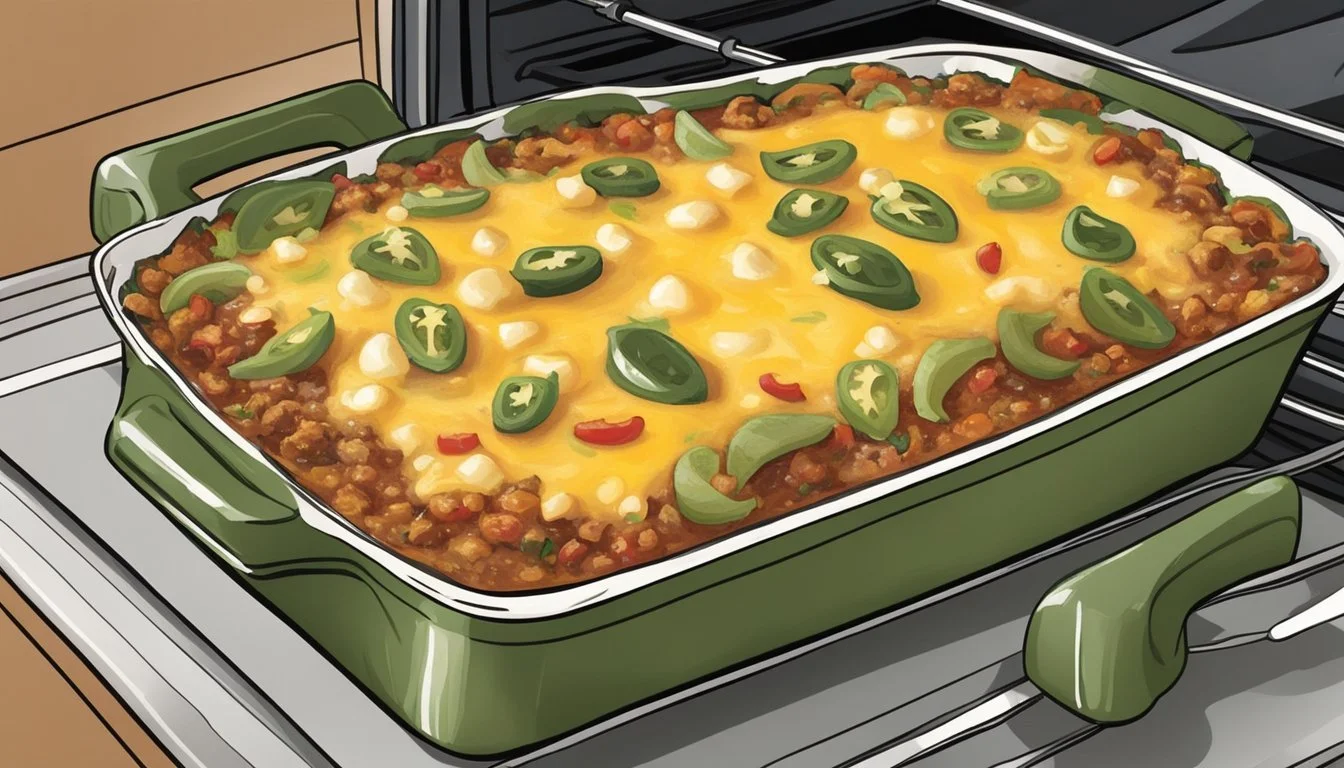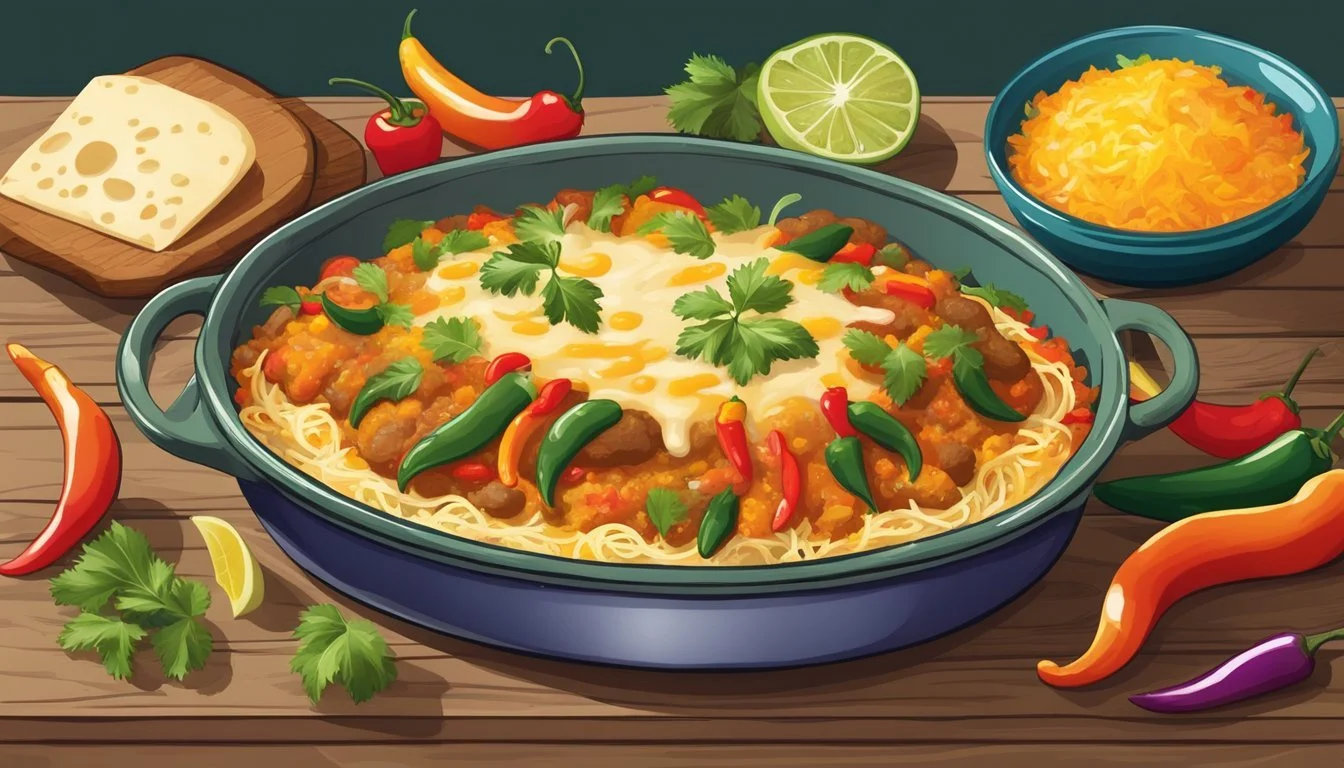Best Way to Reheat Chili Relleno Casserole
Ensuring Melty Cheese & Tender Peppers
Chile relleno casserole, with its blend of tender peppers and gooey cheese wrapped in a fluffy egg-based batter, is a beloved dish that lends itself beautifully to being made ahead of time. However, the true challenge arises when it comes to reheating leftovers. The goal is to maintain the casserole's delightful textures—the meltiness of the cheese and the softness of the peppers—without compromising on its freshly-baked taste.
Finding the best way to reheat chili relleno casserole requires a method that avoids the sogginess or rubberiness that microwaving can sometimes cause. It involves a gentle yet thorough reheat, ensuring the cheese is adequately melted and the peppers remain tender.
Different reheating techniques can be employed to achieve these objectives, each with its own set of steps to best preserve the integrity and flavor of the casserole. Monitoring temperature and timing plays a crucial role in these methods, as they are the determining factors in attaining a desirable, evenly heated end product that mirrors the original dish's appeal.
Understanding Chile Relleno Casserole
The Chile Relleno Casserole is a deconstructed twist on the classic Mexican dish, offering a simpler and family-friendly way to enjoy the flavors of traditional chile rellenos.
Key Ingredients
Eggs: Essential for binding the casserole, providing structure and rich flavor.
Flour: Often used to create a light batter, lending the casserole a delicate texture.
Peppers: Poblano peppers are typically used for their mild heat and full-bodied taste.
Cheese: A combination of shredded pepper jack and cheddar is melted throughout the dish, contributing to its gooey and savory profile.
Nutritional Content: While exact values vary, the casserole generally includes protein from eggs and dairy, with an array of vitamins from the peppers.
Traditional Preparation
Peppers: Roasted poblano peppers are layered in a baking dish, creating the casserole's foundation.
Filling: The peppers can be stuffed with various fillings, like shredded chicken, though a mixture involving cheese is more common in the casserole variant.
Batter: A blend of eggs, flour, and seasonings is poured over the peppers and cheese.
Baking: The entire casserole is then baked until it achieves a golden-brown appearance and the cheese is perfectly melted.
Freezer-Friendly: This dish is well-suited for freezing and reheating, maintaining its delicious qualities when properly stored.
Pre-Reheating Considerations
Before reheating your chili relleno casserole, it's important to consider both food safety and how the casserole has been stored. These steps ensure that the casserole is not only safe to eat but also retains its quality during the reheating process.
Food Safety
Storage Temperature: The casserole should have been stored in the refrigerator at or below 40°F or in the freezer at 0°F immediately after cooling down. Reheating Timeframe: If stored in the refrigerator, it is advisable to reheat the casserole within three to four days. For frozen casseroles (What wine goes well with casseroles?), reheating within two to six months would ensure optimal quality.
Casserole Storage Tips
Refrigerator Storage: Wrap the casserole dish tightly in foil or plastic wrap, or transfer to an airtight container to prevent drying out.
Freezer Storage: If storing in the freezer, proper wrapping is crucial to prevent freezer burn. First wrap in plastic to keep moisture in, then in foil to protect from temperature changes.
Using these pre-reheating protocols will help maintain the texture and flavor of your chili relleno casserole, making it almost as good as when it was first made.
Reheating Techniques
When reheating a Chili Relleno Casserole, ensuring the cheese stays melted and the peppers tender is crucial. The following reheating methods highlight specific techniques to help maintain the integrity of the dish.
Oven Method
An oven is ideal for reheating Chili Relleno Casserole. Preheat the oven to 350°F. Remove the casserole from the refrigerator and let it come to room temperature for about 30 minutes, which aids in even reheating. Cover the casserole dish with foil to prevent the cheese from burning and retain moisture. Place the baking dish in the oven and reheat for 20-30 minutes, or until it's heated through. If a golden color on the cheese is desired, remove the foil in the last 5 minutes of reheating.
Microwave Tips
If time is of the essence, the microwave can be used to reheat leftovers. To avoid overcooking, reheat the casserole in 1-minute increments at 50% power, checking regularly. For best results, redistribute the pieces in the dish between intervals to promote uniform heating. While it's not the best method for achieving a golden top, it's quick and efficient.
Avoiding Sogginess
Retaining the casserole's texture is key in the reheating process. For the oven, using a casserole dish that distributes heat evenly is recommended and don't forget to add a few drops of water before covering with foil to add moisture. When microwaving, cover the dish with a damp paper towel to provide the necessary steam. It's important not to overheat as this can lead to a soggy casserole.
Maintaining Nutritional Value
Reheating a chili relleno casserole can potentially impact its nutritional content. When reheating, it's important to preserve the integrity of key nutrients such as protein, fiber, and vitamins.
To maintain protein quality, which is crucial for muscle repair and overall health, the casserole should be heated gently. Excessive heat can denature proteins, making them less bioavailable. For fiber, found in the pepper's skin, a gentle reheat ensures that the fibrous structure is not broken down excessively, which is vital for digestive health.
The casserole's fat content, especially saturated fat, should be considered. Reheating should be done in a way that doesn't add unnecessary extra fat. Using a method like baking instead of pan-frying in oil can control the addition of fats and help in maintaining the original nutritional profile.
Micronutrients, like vitamin A and vitamin C found in chili peppers, are sensitive to heat. Overheating can degrade these vitamins. To retain them, cover the casserole when reheating to create a moist environment that helps prevent nutrient loss.
Keep an eye on the carbohydrates and sugars if the recipe includes ingredients that can caramelize or change structure when heated, potentially altering both taste and nutritional impact.
Lastly, reheating should avoid further contribution to cholesterol, sodium, potassium, and calcium levels. Using no extra salt or cheese when reheating helps manage sodium and cholesterol intake while maintaining the casserole's existing potassium and calcium content.
Taking these steps can help maintain the casserole's nutrition profile, delivering not just a tasty meal, but one that contributes beneficially to one's daily dietary needs.
Enhancing the Flavor Profile
When reheating chili relleno casserole, the selection of cheese and the careful addition of herbs and spices are pivotal in elevating the taste.
Cheese Varieties
The type of cheese used in a chili relleno casserole not only affects the flavor but also the texture after reheating. For a classic taste, shredded Monterey Jack cheese offers a mild and creamy flavor. To introduce a slight kick without overwhelming the peppers, Pepper Jack cheese, with its flecks of chili peppers, is an ideal choice. For those preferring a sharper profile, cheddar cheese could be added to the mix, enhancing the overall depth of the casserole's flavor.
Jack Cheese: Mild and melts well, perfect for a gooey texture.
Monterey Jack Cheese: A balance of buttery and slightly tart, helps maintain creamy consistency.
Pepper Jack Cheese: Adds a spicy kick with every bite while keeping the texture smooth.
Cheddar Cheese: Provides a sharper tang and a more pronounced cheese flavor.
Herbs and Spices
A thoughtful combination of herbs and spices can accentuate the inherent flavors of a chili relleno casserole. Cilantro can be incorporated for a fresh, herbaceous note, while paprika lends a subtle smokiness that complements the roasted peppers. Garlic powder contributes a savory warmth, essential for rounding out the taste. To ensure the spices integrate well, one should season with kosher salt judiciously to elevate the other flavors without dominating.
Herbs
Cilantro: Offers a fresh burst that contrasts the richness of the cheese.
Spices
Paprika: A pinch creates a smoky undercurrent.
Garlic Powder: Adds depth and a comforting warmth.
It's important to sprinkle these spices evenly throughout the casserole to achieve a harmonious flavor profile upon reheating.
Serving Suggestions
The Chili Relleno Casserole can seamlessly transition from a hearty breakfast to a satisfying dinner with the appropriate accompaniments. One should select side dishes that complement the casserole's rich and cheesy profile, ensuring a balanced meal experience.
Breakfast Options
For those enjoying the casserole in the morning, Mexican rice or hash browns provide a savory base that blends well with the egg and cheese elements. They might consider pairing with roasted tomatoes for a slight acidity to cut through the richness, or a dollop of sour cream for added creaminess. The inclusion of a fresh salsa or pico de gallo serves as a vibrant garnish that not only adds color but also a refreshing contrast in flavors.
Spanish Rice: A classic Mexican breakfast side that balances each bite.
Sour Cream: Adds a tangy, creamy element that complements the bold flavors.
Hash Browns: Offer a crispy texture contrast to the tender peppers.
Pico de Gallo: A fresh tomato salsa garnish that can brighten up the meal.
Dinner Pairings
When served for dinner, the casserole should ideally be flanked by sides that can stand up to its robustness. Black beans provide a high-fiber addition that matches well with the casserole's taste profile, while a corn salad can introduce a light and refreshing angle to the meal. Diners may also opt for a bean and corn salad for a mix of textures and flavors, or a simple garnish like chopped cilantro to add a fresh note. For a more substantial pairing, they can opt for a soup, such as chicken tortilla soup, which complements the casserole's comforting nature.
Black Beans: Adds a satisfying textural contrast and fiber content.
Corn Salad: A light side to offset the casserole’s richness.
Chicken Tortilla Soup: A warm and comforting choice that pairs nicely.
Cilantro: A fresh burst when sprinkled as garnish over the casserole.






